
Rosa rugosa is a species of rose native to eastern Asia, in northeastern China, Japan, Korea and southeastern Siberia, where it grows on beach coasts, often on sand dunes. It should not be confused with Rosa multiflora, which is also known as "Japanese rose". The Latin word "rugosa" means "wrinkled", referring to the wrinkled leaves.

Pieris is a genus of seven species of shrubs in the flowering plant family Ericaceae, native to mountain regions of eastern and southern Asia, eastern North America and Cuba. Known commonly in North America as andromedas or fetterbushes, they are broad-leaved evergreen shrubs growing to 1–6 metres tall and 3–10 ft (0.9–3.0 m) wide. The leaves are spirally arranged, often appearing to be in whorls at the end of each shoot with bare stretches of shoot below; they are lanceolate-ovate, 2–10 cm (0.8–3.9 in) long and 1.0–3.5 cm (0.4–1.4 in) broad, leathery textured, and with an entire or serrated margin. The young leaves in spring are typically brightly coloured. The flowers are bell-shaped, 5–15 mm (0.2–0.6 in) long, white or pink, and arranged in racemes 5–12 cm (2.0–4.7 in) long. The fruit is a woody capsule which splits into five sections to release the numerous small seeds.

Kalmia is a genus of about ten species of evergreen shrubs from 0.2–5 m tall, in the family Ericaceae. They are native to North America and Cuba. They grow in acidic soils, with different species in wet acid bog habitats and dry, sandy soils.

Vaccinium corymbosum, the northern highbush blueberry, is a North American species of blueberry which has become a food crop of significant economic importance. It is native to eastern Canada and the eastern and southern United States, from Ontario east to Nova Scotia and south as far as Florida and eastern Texas. It is also naturalized in other places: Europe, Japan, New Zealand, the Pacific Northwest of North America, etc. Other common names include blue huckleberry, tall huckleberry, swamp huckleberry, high blueberry, and swamp blueberry.

Lycopus is a genus in the family Lamiaceae. They are all herbaceous plants native to Europe, Asia, Australia, and North America. The species are most often found in wetlands, damp meadows, and stream banks. Some of the wetland species have become endangered.

Lycoris is a genus of 13–20 species of flowering plants in the family Amaryllidaceae, subfamily Amaryllidoideae. They are native to eastern and southern Asia in China, Japan, southern Korea, northern Vietnam, northern Laos, northern Thailand, northern Burma, Nepal, northern Pakistan, Afghanistan, and eastern Iran. They were imported into North Carolina and now grow wild. In English they are also called hurricane lilies or cluster amaryllis. The genus shares the English name spider lily with two other related genera.
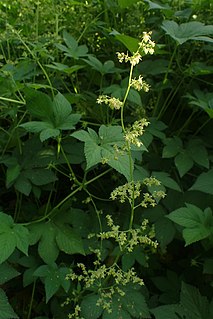
Humulus japonicus, known as Japanese hop, is an ornamental plant in the family Cannabaceae. Some authorities have it as a synonym of Humulus scandens.
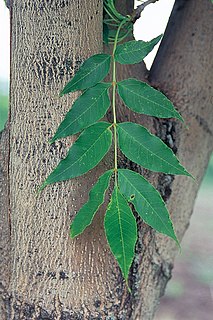
Fraxinus mandshurica, the Manchurian ash, is a species of Fraxinus native to northeastern Asia in northern China, Korea, Japan and southeastern Russia.

Mentha canadensis is a species of mint native to North America and the eastern part of Asia. In North America, it is commonly known as Canada mint, American wild mint, and in Asia as Chinese mint, Sakhalin mint, Japanese mint, and East Asian wild mint. The flowers are bluish or have a slight violet tint. The plant is upright, growing to about 4–18 in (10–46 cm) tall. Leaves grow opposite from each other, and flower bunches appear in the upper leaf axils. The mint grows in wet areas but not directly in water, so it will be found near sloughs, and lake and river edges. Plants bloom from July to August in their native habitats.

Prunus grayana is a species of bird cherry native to Japan and China, occurring at medium altitudes of 1,000–3,800 m in the temperate zone. It prefers sunshine and moist soil.
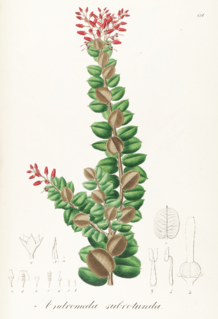
Agarista is a genus of plants in the family Ericaceae. Agarista species contain grayanotoxins, a group of closely related neurotoxins named after Leucothoe grayana, native to Japan.

Corylus heterophylla, the Asian hazel, is a species of hazel native to eastern Asia in northern and central China, Korea, Japan, and southeastern Siberia.

Syringa reticulata, the Japanese tree lilac. is a species of flowering plant in the family Oleaceae native to eastern Asia, which is grown as an ornamental in Europe and North America.

Prunus tomentosa is a species of Prunus native to northern and western China, Korea, Mongolia, and possibly northern India. Common names for Prunus tomentosa include Nanjing cherry, Korean cherry, Manchu cherry, downy cherry, Shanghai cherry, Ando cherry, mountain cherry, Chinese bush cherry, and Chinese dwarf cherry.

Malus baccata is an Asian species of apple known by the common names Siberian crab apple, Siberian crab, Manchurian crab apple and Chinese crab apple. It is native to much of northern Asia, but is also grown elsewhere as an ornamental tree and for rootstock. It is used for bonsai. It bears plentiful fragrant white flowers and edible red to yellow fruit of about 1 cm diameter.

Eubotrys racemosa is a species of flowering plant in the heath family known by the common names fetterbush, swamp doghobble, and swamp sweetbells.

Leucothoe fontanesiana, also known as the highland doghobble, fetter-bush, mountain doghobble or switch ivy, is a species of flowering plant in the family Ericaceae, native to the southeastern United States. It is an erect evergreen shrub growing to 1–2 m (3–7 ft) tall by 3 m (10 ft) broad, with laurel-like glossy leaves 6–16 cm (2–6 in) long, and pendent axillary racemes of urn-shaped flowers in spring.
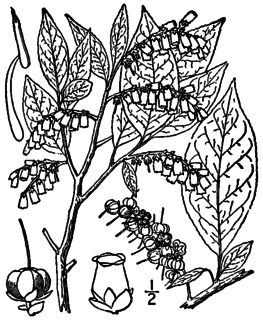
Eubotrys recurva is a plant species native to the eastern United States. Common names include deciduous mountain fetterbush and red-twig doghobble.
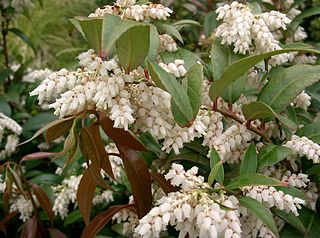
Leucothoe axillaris is a shrub native to the southeastern United States, with the common names swamp dog-laurel and coastal dog-hobble. It has been reported from Louisiana, Mississippi, Alabama, Florida, Georgia, North and South Carolina and Virginia. It grows on floodplains in coastal areas at elevations of less than 200 m (660 ft).

Persicaria sagittata, common names American tearthumb, arrowleaf tearthumb, or arrowvine, is a plant species widespread in the eastern half of North America as well as in eastern Asia. It has been found in every state and province from Texas to Manitoba to Newfoundland to Florida, plus Colorado and Oregon. It also grows in China, the Russian Far East, Siberia, Korea, Japan, northern India and Mongolia. It grows in moist areas along lake shores, stream banks, etc.




















